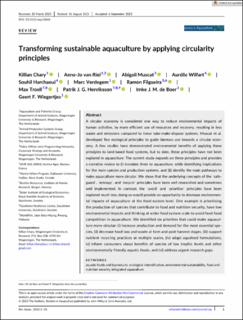| dc.description.abstract | A circular economy is considered one way to reduce environmental impacts of human activities, by more efficient use of resources and recovery, resulting in less waste and emissions compared to linear take-make-dispose systems. Muscat et al. developed five ecological principles to guide biomass use towards a circular economy. A few studies have demonstrated environmental benefits of applying these principles to land-based food systems, but to date, these principles have not been explored in aquaculture. The current study expands on these principles and provides a narrative review to (i) translate them to aquaculture, while identifying implications for the main species and production systems, and (ii) identify the main pathways to make aquaculture more circular. We show that the underlying concepts of the ‘safeguard’, ‘entropy’, and ‘recycle’ principles have been well researched and sometimes well implemented. In contrast, the ‘avoid’ and ‘prioritise’ principles have been explored much less; doing so would provide an opportunity to decrease environmental impacts of aquaculture at the food-system level. One example is prioritising the production of species that contribute to food and nutrition security, have low environmental impacts and thinking at wider food system scale to avoid feed-food competition in aquaculture. We identified six priorities that could make aquaculture more circular: (i) increase production and demand for the most essential species, (ii) decrease food loss and waste at farm and post-harvest stages, (iii) support nutrient recycling practices at multiple scales, (iv) adapt aquafeed formulations, (v) inform consumers about benefits of species of low trophic levels and other environmentally friendly aquatic foods, and (vi) address urgent research gaps. | en_US |
